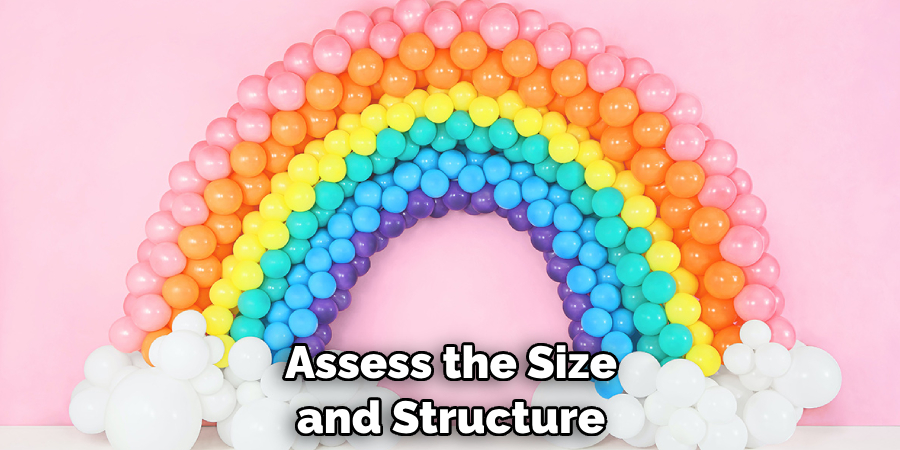Transporting a balloon arch can be a tricky task, as the delicate nature of balloons makes them prone to popping or deflating during transit. Whether you’re planning to transport a balloon arch for a party, event, or any other occasion, proper handling and preparation are essential. A well-executed transportation plan will ensure that your balloon arch arrives intact and ready to be displayed.

From securing the balloons to providing adequate support, there are several key steps to consider. In this article, we will guide you through the process of how to transport balloon arch, providing you with valuable tips and techniques to prevent any mishaps along the way. Get ready to transport your balloon arch with ease, ensuring a stunning display that will impress all who see it!
The Importance of Properly Transporting a Balloon Arch
Transporting a balloon arch is not as easy as it looks. It requires skill, knowledge, and patience to ensure that the arch arrives undamaged and intact for your event. With the right techniques, you can transport a balloon arch securely without any hassle or risk of damage.
When transporting a balloon arch, the key factor to consider is organization. Make sure that all the balloons and pieces of the arch are secured and neatly packed. This helps avoid damage while in transit, such as crushing or popping balloons from jostling around during transport.
It is also important to make sure that there is adequate padding around the arch to ensure its protection from any bumps or shocks along the way.
Another factor to consider when transporting a balloon arch is temperature regulation. Balloons can be sensitive to extreme temperatures, so it’s best to avoid exposing them to hot or cold temperatures for extended periods of time.
Assessing the Size and Structure of the Balloon Arch
Before you can start transporting your balloon arch, it is important to assess the size and structure. This will help you determine the best method of transportation and make sure that the arch does not get damaged during transit.

When assessing the size, remember to take into account how large it is when inflated, as well as any additional decorations or accessories that may be added. If possible, measure the arch and record its dimensions before you start to disassemble it.
The structure of the balloon arch is also important. Note any special shapes or configurations that need to be considered when transporting the arch. Additionally, pay attention to how each component is attached and if there are any intricate pieces that need extra care during transport.
Identifying Fragile or Delicate Balloons or Decorations
When building a balloon arch, it is important to identify all the pieces that may require special care while transporting. If there are balloons with fragile designs or delicate decorations, they should be transported in such a way that reduces the risk of damage.
For example, if you have custom-printed balloons, these should be packed away carefully and not exposed to unnecessary pressure. Similarly, if you have paper decorations or other extras like ribbons or confetti, these too should be protected from possible tearing or crushing. It’s also worth considering cushioning materials like bubble wrap to help reduce any potential impacts during transport.
When transporting an entire arch structure, ensure that the frame is firmly secured and protected against knocks and drops. Particular attention should be paid to any fragile parts and make sure there is suitable padding around them. Additionally, you may also want to consider packing the arch in a box or solid container for extra protection against potential damage.
10 Methods on How to Transport Balloon Arch
1. Choose Sturdy Balloons:
When creating a balloon arch, it’s crucial to use high-quality, sturdy balloons. Opt for balloons made of thick latex or Mylar, as they are less likely to pop or deflate during transportation. Check for any defects or damage before inflating them, and avoid using low-quality or old balloons, as they are more prone to popping.
2. Inflate Balloons Properly:
Proper inflation is essential for the longevity of your balloon arch. Use a hand pump or an electric balloon inflator to inflate the balloons consistently to the recommended size. Avoid overinflating the balloons, as this can increase the risk of popping. Fill them with the right amount of air or helium to maintain their shape and stability.

3. Use Balloon Clips or Knots:
To secure the ends of the balloons, use balloon clips or tie sturdy knots. Balloon clips are convenient and quick to use, ensuring a secure closure. If you prefer to tie knots, make sure they are tight and double-knotted for added security. This will prevent the balloons from coming loose or untangling during transportation.
4. Reinforce Balloon Arch Structure:
Strengthen the structure of the balloon arch by adding additional support. Use clear fishing line or monofilament to tie the balloons together at various points along the arch. This will help maintain the desired shape and prevent the balloons from shifting or drifting during transit. The added support will minimize the risk of the arch collapsing or losing its form.
5. Protect Balloons with Netting or Plastic Wrap:
To provide an extra layer of protection, cover the balloon arch with netting or plastic wrap. This will help prevent the balloons from rubbing against each other and minimize the risk of them getting damaged by external factors such as wind or friction. Secure the netting or plastic wrap tightly around the arch without causing excessive pressure on the balloons.
6. Create a Sturdy Base:
Building a sturdy base for the balloon arch is crucial for its stability during transportation. Attach the arch to a weighted object such as sandbags, water-filled buckets, or heavy-duty stands. Ensure that the base is securely fastened and provides enough weight to anchor the arch. This will prevent the arch from tipping over or shifting during transit.
7. Secure Balloon Arch:
Prioritize the secure attachment of the balloon arch to the transportation vehicle. Use sturdy ropes or bungee cords to tie the base of the arch to the vehicle’s hooks or tie-down points.
Double-check the stability and tightness of the ties, ensuring that they can withstand the movement and vibrations during transportation. Regularly inspect the ties throughout the journey to ensure they remain secure.
8. Provide Cushioning:
To protect the balloon arch from jostling or impact, provide sufficient cushioning during transportation. Place soft materials such as blankets, foam padding, or bubble wrap around the arch. These materials will act as a protective barrier, minimizing the risk of balloons popping or getting damaged due to any sudden movements or external pressure.

9. Avoid Extreme Temperatures:
Balloons are sensitive to temperature changes. Avoid transporting the balloon arch in extreme heat or cold, as these conditions can cause the balloons to expand or deflate. Keep the balloons in a temperature-controlled environment as much as possible. If necessary, use insulated containers or coolers to maintain a moderate temperature during transportation.
10. Handle with Care:
Throughout the transportation process, handle the balloon arch with utmost care. Avoid contact with sharp objects or rough surfaces that could puncture or damage the balloons. Drive carefully, avoiding sudden stops, turns, or bumpy roads that may cause the arch to shift or collapse.
Ensure that the balloon arch is properly secured and supported within the transportation vehicle to minimize movement and maintain its structure.
Things to Consider When Transporting Baloon Arch
When transporting a balloon arch, it is important to remember that balloons can pop very easily and are difficult to replace. To ensure the balloon arch remains intact during transport, there are several things you should take into consideration:
1. Choose the Right Vehicle for Transport.
Make sure the car or truck you choose has enough room for your balloon arch and any other materials needed to put it together. Ensure that your vehicle is free of sharp objects, such as nails or screws, which could puncture the balloons.
2. Protect the Arch from Extreme Temperatures.
The temperature inside a closed-up car can become extremely hot or cold over time and may cause damage to the balloons in your balloon arch if not properly prepared for transport. To protect your balloons, consider keeping the windows open or using a fan to keep the temperature at a comfortable level during transport.
3. Secure the Arch in the Vehicle.
When transporting an arch, it is important to make sure that it is securely held in place within the vehicle. This can be done by tying down the arch with straps or bungee cords or by using foam blocks and other padding to keep it secure.

Conclusion
Through this blog post, we’ve explored the many ways and possibilities of safely transporting a balloon arch. From renting out an appropriate vehicle to opting for a balloon arch kit, you must choose whatever works best for you and your event. It is important to remember that no matter which route you take, safety should be your top priority.
Make sure to wear protective gear like gloves or goggles if needed, secure any straps and cushions properly, check all corners before driving off with your balloon arch intact, and never leave it unattended during transport.
With these tips in hand, you will be able to make sure that your glass slippers arrive safe and sound at the end of your ride! Thank you for reading our post on How to Transport Balloon Arch! For more information about creating beautiful displays with balloons, check out our website here.

